No one would argue against measures to keep our air
Page 46
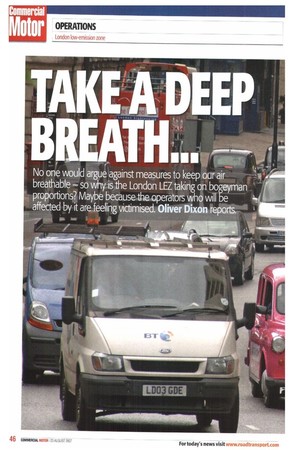
Page 48

Page 49
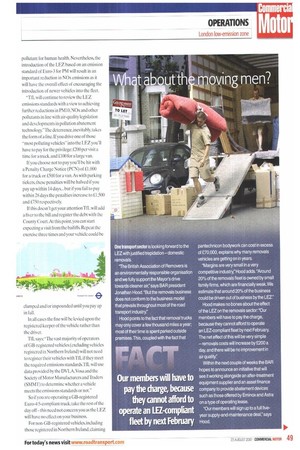
Page 50

Page 51
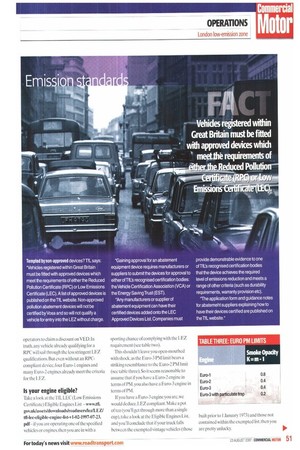
Page 52
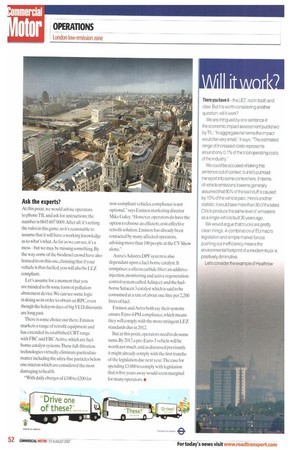
Page 53
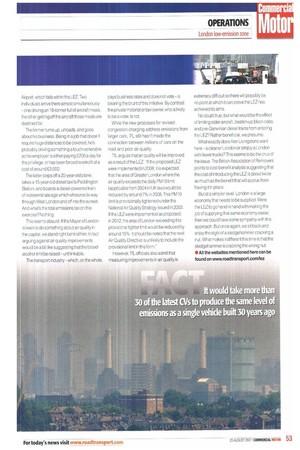
If you've noticed an error in this article please click here to report it so we can fix it.
breathable — so why is the London LEZ taking on bogeyman proportions? Maybe because the operators who will be
affected by it are feeling victimised. Oliver Dixon reports.
London's low-emission zone or LEZ -comes into being on 4 February 2008. As always when legislation and the transport industry collide, there is concern and confusion. But before we examine these issues let's take a look at what the LEZ is, where it will apply and who it will affect.
The aim of the LEZ is simple and, to our minds, laudable. It seeks to improve air quality in the capital by deterring the use of what Transport for London (TFL) describes as the "most polluting vehicles".The LEZ pretty much follows the Greater London Authority boundary:The M25, which passes through the GLA's demesne, is exempt, but other through routes such as the M11Blackwall Tunnel-A2 are not.
As with the congestion charge, cameras will police the area, andTfL is currently talking in terms of 60 enforcement devices.
How many vehicles will be affected? The answer isn't straightforward because 4 February 2008 marks the beginning of a process rather than the imposition of a finalised legislative framework (see table one).
But according to TfL: "The estimated number of vehicles affected by the Low Emission Zone travelling through London is approximately 160.000. TfL estimates that 60.000 of these are currently non-compliant. TfL anticipates that the majority of these vehicles will become compliant before the appropriate Low Emission Zone launch date."
LEZ timetable
Initially the LEZ will apply only to vehicles with a GVW over 12 tonnes. What the TfL describes as "lighter lorries"CVs with GV1.Vs of 3.5-12 tonneswill be covered from July 2008. So by this time next year any goods vehicle covered by the drivers' hours regs will also have to comply with the LEZ rules.
But in 2010, the scope of the LEZ is due to be extended again, to include"large vans", which in TfL-speak means CVs with a GVW of 1205-3.5 tonnes.At this point Euro-3 becomes necessary to avoid problems.
Finally, in January 2012,buses and coaches will have to meet Euro-3 in the LEZ, while -large lorries"with a GVW of 12 tonnes and above will have to meet Euro-4 to avoid LEZ charges.Take note, however, that when referring to Euro emissions protocols we are talking about PM output alone; NOx (nitrogen oxide) seems to have passed TfL by.
CM asked TfL about this omission. Its response was thus: "TfL has focused on particulate matter because this is the most harmful pollutant for human health. Nevertheless, the introduction of the LEZ based on an emission standard of Euro-3 for PM will result in an important reduction in NOx emissions as it will have the overall effect of encouraging the introduction of newer vehicles into the fleet.
"TfL will continue to review the LEZ emissions standards with a view to achieving further reductions in PM10,NOx and other pollutants in line with air-quality legislation and developments in pollution abatement technology."lbe deterrence, inevitably, takes the form of a fine. If you drive one of those "most polluting vehicles" into the LEZ you'll have to pay for the privilege: £200 per visit a time for a truck. and £100 for a large van.
If you choose not to pay you'll be hit with a Penalty Charge Notice (PCN) of ELMO for a truck or £500 for a van. As with parking tickets, these penalties will be halved if you pay up within 14 days... but if you fail to pay within 28 days the penalties increase to £1,500 and E750 respectively.
If this doesn't get your attention TfL will add a fiver to the bill and register the debt with the County Court.At this point, you can start expecting a visit from the bailiffs. Repeat the exercise three times and your vehicle could be exemption will entail registering them with TfL. Download a form from www.tH.gov.uk/ assets/downloaddroadusers/lez/LEZ/LEZ Vehicle_Registration_Fonn.pdf, or phone 0845 607 0009, or (+44)207310 8998 from abroad. Once again. Euro-4/5 vehicles will not be affected by the LEZ regs, but because the DVLA cannot provide evidence of non-GB vehicles' compliance or otherwise a manual entry has to be made.
Operators who fall into this category must register with the LEZ scheme and obtain written confirmation that they have done so, because from 4 February 2008 vehicles that are compliant but unregistered stand to attract PCNs and the attendant nastiness as detailed previously.
Foreign operators should also note TfL's warning that "recovery of unpaid penalties issued to non-GB-registered vehicles [will be] undertaken by a dedicated European debt recovery agency". We plan to watch this with some interest.
What about Euro-1/2/3?
So much for Euro-4/5... what of Euro-1/2/3? At this point things become messy.According to the SMMT about 5,000 Euro-3 trucks may need "some form of treatment" but it hasn't taken Euro-1/2 into account, as such retrofitting would be economic madness. Unfortunately all Euro-3 vehicles are not created equal, and it is here that TfL demonstrates a surprising lack of background knowledge.
Euro-3 came into force on 1 October 2(X)1. All vehicles registered on or after that date can now go and join their Euro-4/5 brethren on the golf course. Once again, non-GB-registered vehicles need to download and complete forms. but they too are pretty much in the clear.
But a fairly large number of Euro-3 compliant vehicles were pre-registered before the I October 2001 introduction of Euro-3. They will be LEZ compliant because they are Euro-3 compliant, but because LEZ compliance is measured via the DVLA. SMMT and Vosa, it is possible that they will not be seen as LEZ compliant.Tony Pain, marketing director at Daf,says:"This is a big issue. We have 1.600 Euro-3 vehicles that were registered before that date and we estimate there are 5,000 vehicles like this in the industry as a whole." TfL says: -Vehicles which are fully Euro-3 certified, but which were first registered before this standard became mandatory on 1 October 2001 will meet the LEZ standards in 2008. If these vehicles are shown as "compliant" within the TfL register the owner has to take no further action.
-Since DVLA does not hold vehicle emissions data TfL obtained data from the SMMT to identify these 'early adopters' in order that they should already be shown as compliant on the TfL register.
"However, it became clear from enquiries to our helpline and to manufacturers that this data was not 100% complete. and therefore a small number of these vehicles are classed as non-compliant on our register.
"We have asked SMMT to check their records, and manufacturers such as Daf and Scania have already provided additional information which has allowed us to update the register.
"If owners find their Euro-3 vehicles are still reported as non-compliant then they will need to complete a registration form, providing a manufacturer's engine type approval certificate. These Euro-3 vehicles do not have to be inspected by Vosa."
There are issues with defining where Euro3 actually begins, which makes using it as a benchmark for LEZ compliance something of a mockery. But mockery becomes farce when Euro-2 and even Euro-1 engines are brought into the equation.
It all seems rather a long time ago now, but Euro-1 was just that:a starting point. Euro-2 pushed things along a little way in terms of emissions control, but both emissions protocols demanded little more by way of re-engineering than basic tweaks. Euro-3 was the first radical shift, because meeting this standard demanded electronic engine controls.You could argue that things began to get serious with Euro-3.
TfL's view could be summed up as "sure, knock yourself out —use a Euro-1/2 engine in the LEZ and either pay 1200 a day for the privilege, or fit a pollution abatement device". This takes us back to the days of the Reduced Pollution Certificate (RPC) which allowed operators to claim a discount on VED. In truth, any vehicle already qualifying for a RPC will sail through the less stringent LEZ qualifications. But even without an RPCcompliant device, four Euro-1 engines and many Euro-2 engines already meet the criteria for the LEZ.
Is your engine eligible?
Take a look at the 'I'LL LEC (Low Emissions Certificate) Eligible Engines List — www.1-11. govaddassets/downloads/roadusers/lez/LEZ/ pdt'— if you are operating one of the specified vehicles or engines, then you are in with a sporting chance of complying with the LEZ requirement (see table two).
This shouldn't leave you open-mouthed with shock, as the Euro-3 PM limit bears a striking resemblance to the Euro-2 PM limit (see table three). So it seems reasonable to assume that if you have a Euro-2 engine in terms of PM, you also have a Euro-3 engine in terms of PM.
If you have a Euro-3 engine you are, we would deduce, LEZ compliant. Make a pot of tea (you'll get through more than a single cup ), take a look at the Eligible Engines List, and you'll conclude that if your truck falls between the exempted vintage vehicles (those built prior to 1 January 1973) and those not contained within the exempted list, then you are pretty unlucky.
Ask the experts?
At this point, we would advise operators to phone TfL and ask for instructions; the number is 0845 607 0009.After allies setting the rules in this game, so it's reasonable to assume that it will have a working knowledge as to what's what.As far as we can see, it's a mess — but we may be missing something. By the way. some of the biodiesel crowd have also horned in on this one,claiming that if your vehicle is thus fuelled, you will also be LEZ compliant.
Let's assume for a moment that you are minded to fit some form of pollution abatement device, We can see some logic in doing so in order to obtain an RPC, even though the halcyon days of big VED discounts are long past.
There is some choice out there. Eminox markets a range of retrofit equipment and has extended its established CRT range with FBC and FBC Active, which are fuelborne catalyst systems.These full-filtration technologies virtually eliminate particulate matter including the ultra-fine particles below one micron which are considered the most damaging to health.
"With daily charges of £100 to £200 for non-compliant vehicles, compliance is not optional," says Eminox marketing director Mike Galey."However,operators do have the option to choose an efficient, cost-effective retrofit solution. Eminox has already been contacted by many affected operators, advising more than 100 people at the CV Show alone."
Astra's Adastra DPF system is also dependant upon a fuel-borne catalyst. It comprises: a silicon carbide filter: an additiveinjection, monitoring and active regeneration control system called Adinject; and the fuelborne Satacen 3 catalyst which is said to he consumed at a rate of about one litre per 2,200 litres of fuel.
Eminox and Astra both say their systems ensure Euro-4 PM compliance, which means they will comply with the more stringent LEZ standards due in 2012.
But at this point, operators need to do some sums. By 2012 a pre-Euro-3 vehicle will be worth not much,and as discussed previously it might already comply with the first tranche of the legislation due next year.The case for spending £3.000 to comply with legislation that is five years away would seem marginal for many operators. • Airport, which falls within the LEZ. Two individuals arrive there almost simultaneously one driving an 18-tonner full of aircraft meals, the other getting off the aircraft those meals are destined for.
The former turns up, unloads, and goes about his business. Being in a job that doesn't require huge distances to be covered, he's probably driving something a touch venerable so his employer is either paying E200 a day for the privilege, or has been forced to retrofit at a cost of around £3,000.
The latter steps off a 20-year-old plane, takes a 15-year-old diesel taxi to Paddington Station, and boards a diesel-powered train of indeterminate age which wheezes its way through West London and off into the sunset. And what's the total emissions tax on this exercise? Nothing.
This seems absurd. If the Mayor of London is keen to do something about air quality in the capital, we stand right behind him. In fact arguing against air quality improvements would be a bit like suggesting that the bloodalcohol limit be raised unthinkable.
The transport industry-which, on the whole, pays business rates and does not vote is bearing the brunt of this initiative. By contrast the private motorist or taxi owner, who is likely to be a voter. is not.
While the new proposals for revised congestion charging address emissions from larger cars, TfL still hasn't made the connection between millions of cars on the road and poor air quality.
TfL argues that air quality will be improved as a result of the LEZ. "If the proposed LEZ were implemented in 2008, it is expected that the area of Greater London where the air quality exceeds the daily PM10 limit (applicable from 2004 in UK law) would be reduced by around 7% in 2008. This PM10 limit is provisionally tightened under the National Air Quality Strategy issued in 2003. If the LEZ were implemented as proposed, in 2012, the area of London exceeding this provisional tighter limit would be reduced by around 15%. It should be noted that the next Air Quaky Directive is unlikely to include the provisional limit in this form."
However, TfL officials also admit that measuring improvements in air quality is extremely difficult so there will possibly be no point at which it can prove the LEZ has achieved its aims.
No doubt true, but what would be the effect of limiting older aircraft, beaten-up black cabs and pre-Darwinian diesel trains from entering the LEZ? Rather beneficial, we presume.
What exactly does Ken Livingstone want herea cleaner London or simply a London with fewer trucks? This seems to be the crux of the issue. The British Association of Removers points to cost-benefit analysis suggesting that the cost of introducing the LEZ is about twice as much as the benefit that will accrue from having it in place.
But at a simpler level, London is a large economy that needs to be supplied. Were the LEZ to go hand in hand with making the job of supplying that same economy easier, then we could have some sympathy with this approach. But once again, we sit back and enjoy the sight of a sledgehammer cracking a nut. What makes it different this time is that the sledgehammer is cracking the wrong nut.
• All the websites mentioned here can be found on www.roadtransport.com/lez
























































































































































































